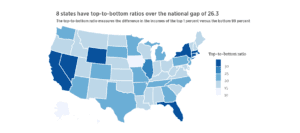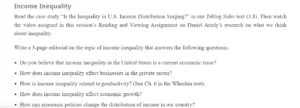Income Inequality
Do you believe income inequality in the United States is a current economic issue?
Inequality in the U.S. affects every part of the country, both urban and rural areas, and financial centers. Reinicke (2018) notes that between 1928 and 1973, the income share of the top 1% populace decreased in almost all states. However, between 2009 and 2015, the income for this population bracket grew at unprecedented rates compared to the bottom 99% of the nation’s population. Although the unemployment rate in the U.S. is at a historic low, the economy is thriving; there has been a stagnation in wage growth. The CEO pay increased 20-fold between 1965 and 2016, more than 270 times that paid to a typical worker. Hence, I believe that income inequality continues to grow in the U.S. The poor are getting poorer while the rich are getting richer.

Income Ratios
Are you looking to acquire an unpublished version of “Income Inequality essay”? Contact us
How does income inequality affect businesses in the private sector?
According to the Borgen Project (2015), economic flexibility, inequality, and poverty are intertwined. Traditionally, inequality has been viewed as the end product of challenges in development, which would recede with poverty reduction efforts and increased growth. However, inequality is a problem and affects the private and public business sectors. When economic growth is unevenly dispersed, it leaves the bottom population behind. Hence, reduction in poverty needs to be in collaboration with equitable resource distribution for it to be effective. Businesses operate to make profits, and poverty means the market for the products is more diminutive. A business like Starbucks will not open doors in a poor community; PLACE is essential to a business’s marketing mix. A privately-owned business will look for an affluent location to start a business, thus, locking out those in the already lower ranks of the economy (the poor and low-income brackets). A private business hires workers, and the salary that these workers earn will go toward meeting their basic needs. A rich person has a higher buying power, but a person in the poor bracket will more likely spend a significant percentage of their income because it is not high. This explains the economic slowdowns and recessions. Most of the population hesitates to spend money on anything outside basic needs. Hence, this causes low business activity, which then worsens economic activity.
How is income inequality related to productivity?
According to the OECD (2016), the high level of income inequality can impact the willingness of organizations and businesses to hire staff to work. Inequality can result in a lack of human capital investment among low-income families (Wheelan, 2010). Additionally, the OECD states that wage dispersion between diverse firms, which reflects diverging productivity growth rates, has caused income inequalities between workers in several incidences. Further, economies’ financialization creates short-term profit maximization at the expense of adequate resource channeling to more productive activities. Traditional measures used in boosting productivity in regulatory frameworks, labor markets, or competition have failed to allow for resource allocation in more productive activities or for increasing specific sector productivity. These have impacted opportunity and income inequalities where workers are un-equipped to handle the changes due to their initial conditions or low skills. The drive toward flexible labor markets has been an advantage to employers and to more productive firms that have benefited from enhanced labor resource allocation. However, the increase in flexibility has resulted in increased cases of work that is non-standard. Low-skilled workers are trapped in low-wage jobs that are precarious and who also receive less training (OECD, 2016)
How does income inequality affect economic growth?
Generally, a negative relationship exists between economic growth and inequality though there is yet to be a cause-and-effect correlation to be established (Castellano, 2017). In the early 50s, inequality was believed to stimulate people to work harder and invest more. People with higher education and better incomes would motivate those in lower ranks to achieve the same. Additionally, it was viewed that the higher the inequality, the greater the growth of the economy, as people in high-income groups would invest or save more. However, time has shown that inequality can negatively impact the economy. For example, greater inequality can result in reduced opportunities for professionals in society’s disadvantaged groups, which would decrease their social mobility and ultimately limit the potential for economic growth. Additionally, increased inequality can result in a parallel increase in credit which halts economic growth (Castellano, 2017)
How can economic policies change the distribution of income in our country?
The government can implement fiscal policies to ensure resource redistribution to minimize the inequality gap (Bonello & Lobo, 2015). Redistribution will mean increasing funding to programs such as Medicaid, SNAP, earned income tax credit, and TANF. The programs are funded by federal income tax; the top 1% should pay higher taxes without using loopholes to evade the higher charges. Further, a ladder of opportunities can be created through public policy where children, though having attended different schools and coming from different families, are given a reasonable opportunity to gain an economic niche (Open Text, n.d). The economic niche in society should be based on the individual child’s efforts, talents, desires, and interests. Some initiatives include internship and apprenticeship; community and after-school services; improved public schools; preschoolers enrichment programs, and improved daycare. For college students, initiatives could consist of public support for education institutions spanning through community colleges to research universities; and grants and loans offered to persons in financial need. For adults, the prohibition of housing and job market discrimination based on disability, age, gender, and race should be encouraged; offering opportunities for acquiring and retraining skills are some public policy initiatives that can be implemented.
Similar Post: Adaptive Structures
References
Bonello, F., & Lobo, I. (2015). Taking Sides: Clashing Views on Economic Issues (16th Ed.).
Borgen Project (2015). Why Inequality Is Bad for Business. https://borgenproject.org/inequality-bad-business/
Castellano, C. (2017). How Does Inequality Affect Economic Growth? https://www.caixabankresearch.com/en/how-does-inequality-affect-economic-growth
OECD Forum (2016). The Productivity And Equality Nexus. http://www.oecd.org/social/productivity-equality-nexus.htm
Open Text (N.D.). Principles Of Economics https://opentextbc.ca/principlesofeconomics/chapter/14-5-government-policies-to-reduce-income-inequality/
Reinicke, C. (2018). U.S. Income Inequality Continues to Grow. https://www.cnbc.com/2018/07/19/income-inequality-continues-to-grow-in-the-united-states.html
Wheelan, C. (2010). Naked Economics: Undressing the Dismal Science. Chapter 6: Productivity and Human Capital
ORDER A PLAGIARISM-FREE PAPER HERE
We’ll wriWe’llerything from scratch
Question
Income Inequality
Read the case study “Is the I”equality in U.S. Income Distribution Surging?” in our taking Sides text (3.8Akingen watch the video assigned in this session’ssession’sand Viewing Assignment on Daniel Ariely’s Ariely on what we think about inequality.

Income Inequality
Write a 3-page editorial on the topic of income inequality that answers the following questions:
- Do you believe income inequality in the United States is a current economic issue?
- How does income inequality affect businesses in the private sector?
- How is income inequality related to productivity? (See Ch. 6 in the Wheelan text).
- How does income inequality affect economic growth?
- How can economic policies change the distribution of income in our country?
Format your paper according to APA guidelines
Website for video
https://www.ted.com/talks/dan_ariely_how_equal_do_we_want_the_world_to_be_you_d_be_surprised
Readings:
Wheelan, C. (2010). Naked economics: Undressing the dismal science.
- Chapter 6: Productivity and Human Capital
Bonello, F., & Lobo, I. (2015). Taking sides: Clashing views on economic issues (16th ed.).
- 6 Does Immigration Benefit the Economy?
- 8 Is the Inequality in U.S. Income Distribution Surging

